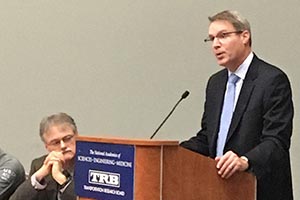Managing Editor, Features and Multimedia
Autonomous Trucks Hold Promise, But Sensible Regulation Is Needed, ATA’s Spear Tells TRB

While the widespread adoption of highly automated trucks is still many years away, “the debate over the regulatory framework that will govern it is happening now, and trucking must be a part of it,” said Spear, one of several speakers to address the topic during a Jan. 9 panel discussion here at the Transportation Research Board’s annual meeting.
“It is important that government policies and regulations do not stifle innovation or inhibit the flexibility of carriers to choose automated technologies best suited to their individual needs,” he said.
Automated driving systems also will need to be demonstrably safer than today’s manually driven vehicles, said Anthony Levandowski, co-founder of Otto, which is developing an automated driving aftermarket kit for heavy-duty trucks.
“The reason we are building this technology is safety,” he said.
Otto, which was acquired last year by Uber, captured the attention of the trucking industry in October by hauling a load of beer for Anheuser-Busch in Colorado, an event the company hailed as the first commercial shipment by a self-driving truck.
The advent of automated driving technology could change the entire conversation about many key challenges facing the industry.
“Most of the issues we encounter in the trucking industry today … could at least be addressed if not negated by autonomous trucks,” said Daniel Murray, vice president of research at the American Transportation Research Institute.
For example, the technology might eliminate the rationale for current hours-of-service requirements such as mandatory rest breaks, which could in turn alleviate the nation’s chronic truck parking shortage.
Automated trucks could help address the driver shortage by attracting millennials to the profession, while also reducing or eliminating the driver distraction issue, Murray said.
Otto’s goal is to develop software that eventually enables trucks to operate without the need for a human to monitor its progress, Levandowski said.
“It’s a repeatable task, which means that over time, machines are going to be able to do it better than people can,” he said. “It’s not where we are today, but that’s where we’re going in the future.”
Anthony Levandowski of @ottodrives: the reason we are building this technology is to improve safety. #TRB2017 pic.twitter.com/tH2jc0Rvl0 — Seth Clevenger (@SethClevenger) January 9, 2017
Even with automated trucks, however, ATA believes the driver “will retain an important role in trucking for the foreseeable future,” Spear said, just as pilots are still present in airplane cockpits.
The role of the driver could shift toward monitoring the automated driving system while still retaining responsibility for securing cargo and interacting with customers, he said.
The federal government should lead the regulation of automated trucks, Spear said, because the industry relies on the free flow of goods between states.
“As automated truck technology is commercialized, it is critical that state and local laws do not create disparities that limit commerce and obstruct the successful adoption of these potential safety- and productivity-boosting technologies,” he said.
The National Highway Traffic Safety Administration last year issued federal guidelines for the testing and deployment of highly automated vehicles. Now the Federal Motor Carrier Safety Administration is taking steps to develop a document to address the unique needs of the trucking industry, Spear said.
States also should review existing laws that could be impediments, such as following distance requirements that may prevent truck platooning, he added.
In contrast, Levandowski’s focus was on the quality of the regulatory environment rather than where it originates.
“The key thing we think is important is that we have sensible regulations,” regardless of whether they come from the federal or state governments, he said.
ATA’s Spear envisions a major role for vehicle connectivity, which he described as the “secret sauce” for unlocking the full potential of automated vehicles.
He reiterated his concern that the Federal Communications Commission is considering action that would allow the band of wireless spectrum allocated for vehicle-to-vehicle safety messages to be used for other purposes, such as Wi-Fi.
That concern was echoed by Skip Yeakel, principal engineer of advanced technology and research at Volvo Group North America, who said the 5.9 gigahertz band designated for vehicle safety “should be preserved, protected and defended at all costs,” unless it can be proven that other uses would not hurt its safety potential.
Levandowski, on the other hand, downplayed V2V, saying it is not a requirement for the introduction of autonomous vehicles.
“I would say it’s fantastic if it’s there, but it’s not the one enabler that would make this happen or not happen,” he said.
In addition to its self-driving truck software, Otto and parent company Uber are developing a freight marketplace aimed at automating transactions between shippers and carriers to improve fleet utilization.
Mark Savage, deputy chief of the Colorado State Patrol, said his experiences helping to oversee Otto’s so-called “beer run” convinced him that automated driving “has the potential to save lives.”
That opportunity to improve road safety through automation also has attracted the interest of public agencies, said Sandra Larson, systems operations bureau director at the Iowa Department of Transportation.
She cited estimates by the National Highway Traffic Safety Administration that 94% of crashes are due in some measure to human error or choice, and 80% could be mitigated or eliminated with automated vehicles.
“This is personal,” Larson said. “We are losing too many people on our highways.”




